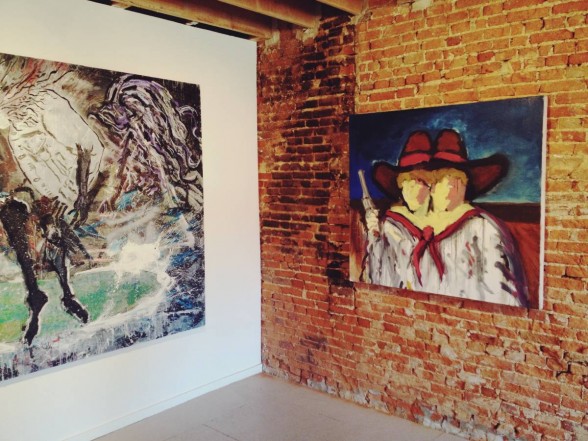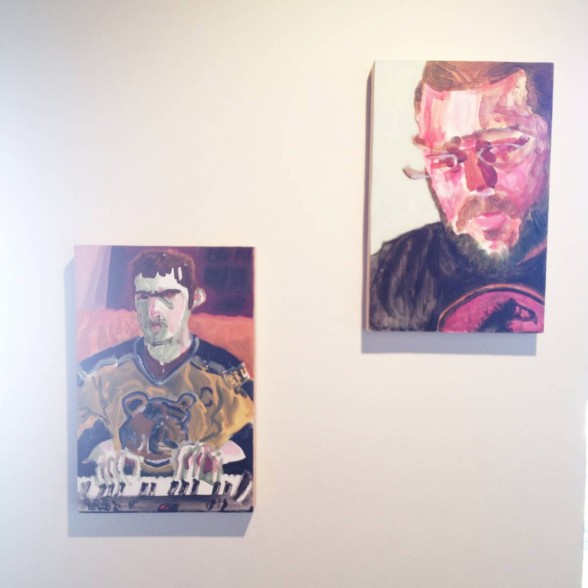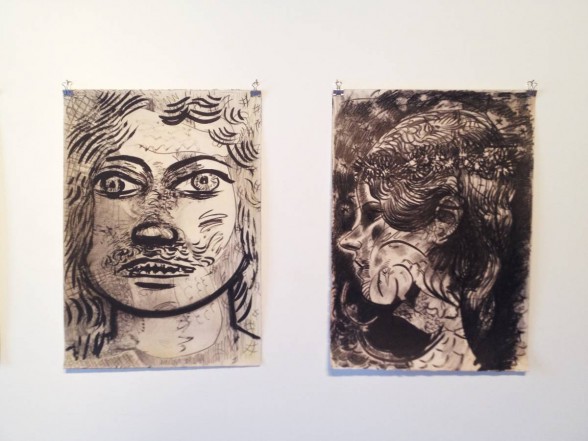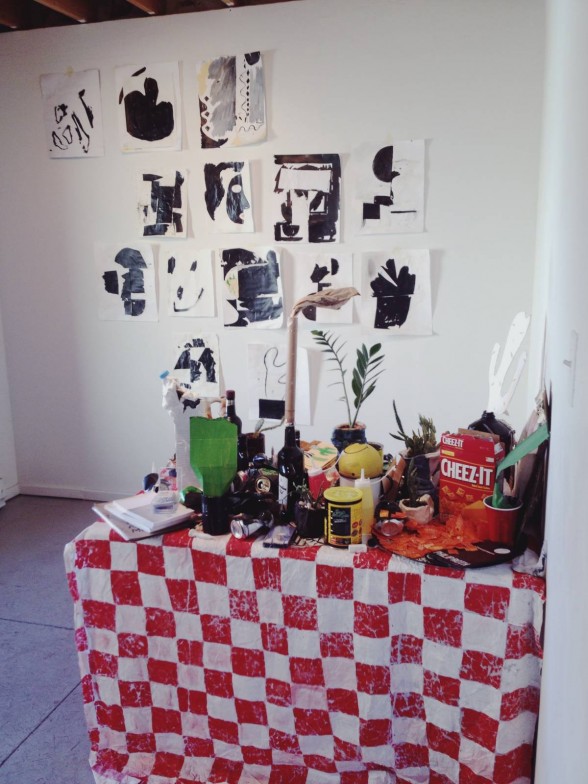[Irena sees promise in a show that approaches the tradition of figurative painting in new ways. — the Artblog editors]
Eight Young Figurative Artists Who Live in Philadelphia at Fjord, a Kensington gallery and artist collective, brings together some of the brightest young talents within the Philadelphia art community working in a figurative field. The primarily painting-based exhibit varies from portraiture to near-abstraction, with a highly modern flair.
From Van Gogh’s unnatural color palettes to the realism of Thomas Eakins, figurative art generally offers an alternative to the abstract in different ways, while also spanning various art genres and time periods. Several immediately captivating pieces in this show reassure any gallery-goer that Eight Young Figurative Artists will blur the lines between figurative and abstract in fresh and elaborate ways.
Playing with representation and media

David Meyers‘ “Two Headed Cowgirl,” a piece hanging in the gallery’s main room, catches viewers’ attention by making a witty and unexpected statement. A woman with two faceless heads and wielding an old-timey pistol cuts the canvas in half, while the use of expressive brush strokes and flat patches of bold color bring the abstracted representation to life.
Shanna Waddell‘s “Bob (Satan),” hanging near “Cowgirl,” is dramatic and surreal, something between a Dali and a Twombly; Waddell executes the work in oil, spray paint, and gift-wrapping paper, offering a variety of textures and shapes. The use of unique media is important when conveying certain moods or senses, and Waddell’s deliberate use of varying elements is no exception. Though not particularly challenging to a traditional sense of figurative art, both Meyers and Waddell explore unique subject matter and enticing material elements to distinguish their pieces.

Yoni Hamburger, an Israeli-born PAFA graduate currently residing in Philadelphia, spoke with me at the gallery, opening up about how his works in the show relate to this exhibit, and what this showcase of artists means in terms of current Philadelphia art movements.
Hamburger believes the city’s thriving art scene offers a “promising alternative” to the often-inaccessible world of art in New York–a city where he has also studied. He believes that the traditional sense of figurative painting must be challenged in order to rightly fit within contemporary standards and aesthetics. The abstracted and avant-garde qualities of the paintings in the show resonate with far more modern tastes. He also believes that Eight Young Figurative Artists is attuned to the ever-changing art scene in Philadelphia.
Hamburger’s own pieces are versatile portraits of “other artists and people I love,” he says. His imagery seems heavily influenced by the German Expressionists and additional art movements that divorced themselves from realistic painting. His piece “Jon Making Music” shows a young man playing keyboards, rendered with heavy brush-work and non-representational colors. A mixture of Impressionistic senses and the drama of Expressionism define Hamburger’s subjects.
Putting it all on the table


In the back room of the gallery, beside two of Hamburger’s pieces, is the surprising installation “Table,” by artist Ryan Foley, made up of varying mixed-media objects, such as a Cheez-It cracker box, household plants, liquor bottles…you name it. “Table” stands before a background of Foley’s highly abstracted works on paper, also mixed media.
Foley’s “Table” is undoubtedly one of the most, if not the most captivating piece in the show. It invites viewers to conceptualize figuration as a three-dimensional form outside of sculpture, not to mention alludes to the question of “Is that even a piece in the show?”, which I am more than convinced was on the minds of at least several viewers. “Table” begs the viewer to approach it in a way that differs from how a traditional piece of art would be approached, and delivers a message with the same unexplainable mystery as an unfinished sentence.
Philadelphia’s roots lie heavily in the figurative tradition–Philly is home to five major art schools, and its most esteemed galleries, including PAFA’s, have historically relied on the easily sellable and equally agreeable realm of figurative painting. Fjord’s surprising take on the tradition of figuration is a reasonable venture; it is understandable why a gallery would exhibit a new twist on a Philadelphia classic at a time when pushing the boundaries of art in distinct ways is more crucial than ever.
Eight Young Figurative Artists Who Live in Philadelphia is on view at Fjord, 2419 Frankford Ave., Philadelphia, PA through Nov. 29, 2014.









